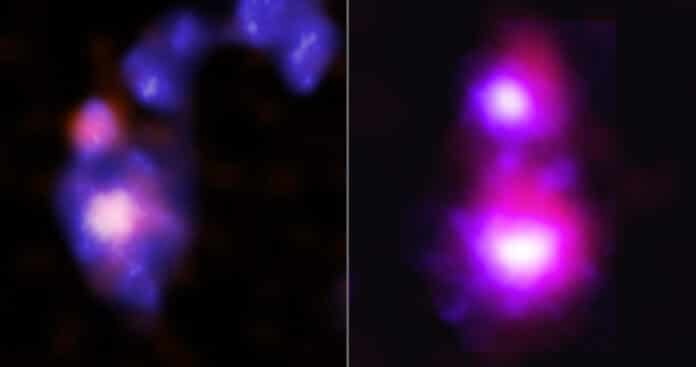A new study using NASA’s Chandra X-ray Observatory has tracked two pairs of supermassive black holes in dwarf galaxies on collision courses. This is the first indication of such an upcoming encounter, giving scientists crucial knowledge about the growth of black holes in the early Universe.
It is well known that dwarf galaxies merge to grow into the larger galaxies seen today. However, current technology cannot observe the first generation of dwarf galaxy mergers because they are extraordinarily faint at great distances.
The current study overcame these hurdles by employing a systematic scan of deep Chandra X-ray observations and combining them with optical data from the Canada-France-Hawaii Telescope and infrared data from NASA’s Wide Infrared Survey Explorer (WISE) (CFHT).
The team searched for pairs of bright X-ray sources in colliding dwarf galaxies as evidence of two black holes and discovered two examples.
The composite image on the left shows one pair in the galaxy cluster Abell 133, 760 million light-years away from Earth. Pink represents Chandra X-ray data, while blue represents CFHT optical data. This pair of dwarf galaxies exhibit a long tail from tidal effects from the collision and seems to be in the last stages of merging.
The current study’s authors have given it the nickname “Mirabilis” after a critically endangered species of hummingbird known for having unusually long tails. Due to the nearly complete merging of two galaxies into one, only one name was chosen. In each galaxy, the two Chandra sources display X-rays from the region surrounding the black holes.
The other pair was discovered in Abell 1758S, a galaxy cluster about 3.2 billion light-years away.
The merging dwarf galaxies were given the names “Elstir” and “Vinteuil” by the researchers in honor of fictional artists from Marcel Proust’s “In Search of Lost Time.” The galaxy at the top is called Vinteuil, and the galaxy at the bottom is called Elstir.
According to scientists, these two have been caught in the early stages of a merger, causing a bridge of stars and gas to connect the two colliding galaxies from their gravitational interaction. Follow-up observations of these two systems will allow astronomers to study processes crucial for understanding galaxies and their black holes in the earliest stages of the Universe.
Journal Reference:
- Marko Mićić, Olivia J. Holmes et al. Two Candidates for Dual AGN in Dwarf-Dwarf Galaxy Mergers. The Astrophysical Journal. DOI: DOI: 10.48550/arXiv.2211.04609
